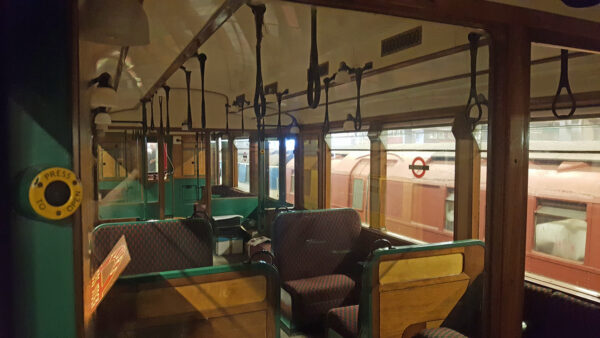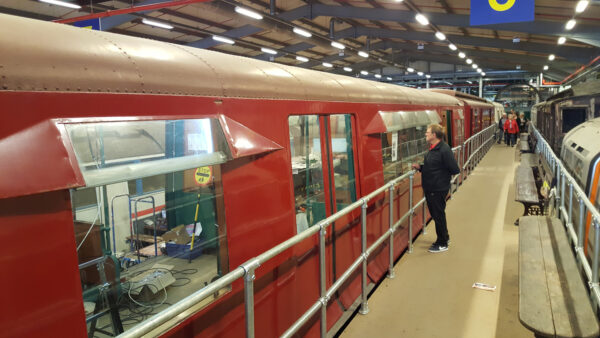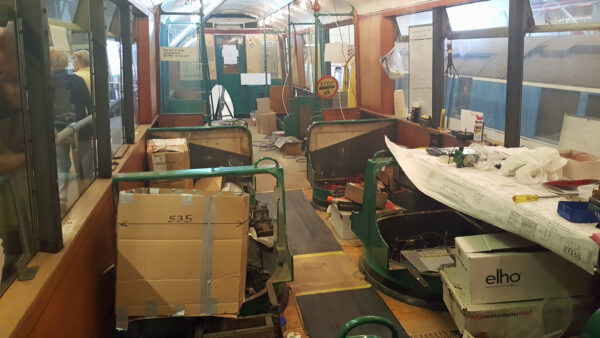A train that hasn’t been seen on the London Underground since 1971 could make a return if plans to restore a collection of Q-Stock carriages can be completed.
Q stock trains first ran on the District line eighty years ago in 1938. For more than 30 years they carried people through key moments in London’s history – from the dark years of the Second World War, through the post-war years of austerity to the swinging sixties.
The London Transport Museum and its volunteers have been working on the restoration for several years, but are now launching a £200,000 fundraising campaign to finish the final steps.
When completed, each restored carriage will tell a different story from the Q stock’s long history, and the aim is for the restored cars to run on heritage services.
The Q stock trains also represented an experimental era of pre-war modernisation on the Underground – particularly the District line, which enters its 150th year in December 2018.
Unlike modern London Underground trains made up of identical carriages, Q stock trains were formed of a combination of sleek new cars, purpose-built in 1938 to run alongside a range of older American-style cars dating as far back as 1923.
Passengers never knew what formation would pull into their platform.
Q stock were the last London Underground trains built in this way, making the three surviving 1930s cars a rare and distinctive part of London’s transport heritage.
The interiors of the last three 1930s Q stock cars will be restored to reflect different moments from their long history running on the tracks. One car will explore life in wartime London, sharing the story of evacuation in 1939 which Q stock trains aided. The second will reflect life during the rebuilding of London in the 1940s. The third will illustrate the growing optimism and prosperity of the 1950s.
Running together, the different Q stock cars revealed the evolution of train design on the London Underground. The Q stock car built in 1935 is the last-surviving train car in Britain to have been built with a classic American-style raised roof, known as a clerestory. This design was first brought to Britain in 1875 by American engineer George Mortimer Pullman. This car also has a first-class section, last in use on Underground services in 1941.
In contrast, the Q stock cars built in 1938 have smooth, curved roofs. They also have sleek, flared sides, a radical styling unique to the 1930s. The design of these newer cars represents an experimental pre-war period of modernisation ushered in by the establishment of the London Passenger Transport Board in 1933.
Work on the interiors of the cars has already begun, thanks to London Transport Museum Friends and a legacy left by the late Bob Greenaway who served for 35 years with London Underground.
Volunteers are helping to get the train back into working condition at London Transport Museum’s depot in Acton.
But £200,000 is still needed to complete the restoration:
- £5 will light up one of 250 1930s fluted lampshades.
- £15 will decorate the cars with a reproduction poster from the 1930s to 1960s.
- £50 will fit a panel of original lacewood along the interior walls of the cars.
- £100 will help paint the cars in their classic train red, cerulean blue or gold.
- £330 will cover a seat with moquette in a vintage design.
- £8,000 to repair one air compressor needed to power up the doors and breaks of the cars. Two compressors need repairing.
- £25,000 to overhaul the mechanical engineering of a brake van to safely slow and stop the cars once up and running. Two brake vans require restoration.
More details and the fundraising page is here.










I hope they put a totalliser on the website to show how funding is going.
Are you joking? They wont do that. Because then no one will donate when they reach 200k. This way everyone is going to donate and they might make 300 or 400 etc. They’re not stupid
There is a totaliser on the website.
We have older ones running daily here on the Isle of Wight.
The Q Stock carriages were built between 1935-1938, while the trains of the Isle of Wight were built in 1939.
Very very good point!
I give it a day before someone adds graffiti to it. Sadly.
Surprised they’re not passing it off to Northern Fail as new stock.
What happened to the 4th remaining Q stock car, also with clerestory?
The LTM has 2 1923 Q Stock cars, one on the Museum in Covent Garden and one at the Acton Depot. The CG one will remain in static display in the condition it left service in 1971. The other car could be restored but would be much more expensive as more parts are missing than the 3 from the 30s, and so hasn’t been included in this part of the project.
Thanks James.
It’s a beautiful idea but there are so many more people in London now some who have zero appreciation for British History let alone history in general.
I just hope they appreciate the hard work and effort that is going into giving them art and culture.
I think it would be far better to turn those carriages into a money spinning idea of restaurant cars serving up British teas to visitors whom I think would be far more appreciative than some.
There are plenty of British people that have no idea of British history…
Sounds like a good idea.
I travelled daily on these trains to the East London FE college between 1966-68 on the East London Line. The Q23 carriages with their square ends to the clerestory roofs always stood out in a rake of mixed 1927, 1935 and 1938 carriages. The inside decorative iron work, swan neck lights and straps gave an almost Edwardian ambiance to the journey from New Cross Gate to Whitechapel.